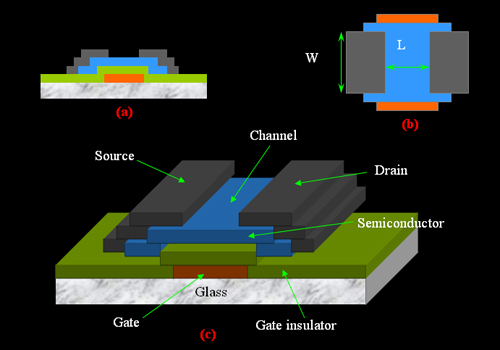[Thin Film Transistor
Film (TFT)]
The TFTs in
active-matrix LCD act as simple ON/OFF switches, at different speeds
which depend on the refresh rate of the LCD, for example 60Hz.
Figure 1 shows a simple structure of TFT, it consists of three
terminals: the gate, the source and the drain. As seen in figure 1,
the gate is insulated from the semiconductor film by a gate
insulation film; while the drain and source directly contact the
semiconductor film.

Figure 1. A
simple Thin-Film-Transistor (TFT) structure
In a simple TFT, for example
N-channel TFT, a positive voltage is applied on the gate in order to switch it
ON; the insulation layer can be considered as the dielectric layer in a
capacitor, hence negative charges are induced on the semiconductor channel,
which is the region between source and drain; these negative charges create a
electrons flow from source to drain to make the channel conductive. When a
negative voltage is applied on the gate, electrons are depleted in the channel,
hence almost no current is present. The ON current depends on different
parameters, for example channel width, channel length, gate voltage and the
threshold voltage of the TFT.
When the TFT is switched ON, a
data voltage is applied on the source, the drain with the LC load capacitance
will charge up to the voltage with same amplitude, i.e. transferring the data
voltage from the data line to the pixel electrode. When switched OFF, no current
in the channel, and data voltage cannot be transferred.
The first TFT for LCD was made
of Cd-Se semiconductor thin films, however this is not compatible with normal
process. In spite AMLCD with Cd-Se has a better performance, its
commercialization is still not success.
While a P-channel TFT can be
switched ON by applying a negative voltage on the gate, and can be switched OFF
by a positive voltage on the gate.
TFTs can be formed by three
different silicons, they are: crystalline silicon, poly-silicon and amorphous
silicon; and in practical manufacturing, poly-silicon can also be processed
under low and high temperature, i.e. Low-Temperature Poly-Silicon (LTPS) which
can be built on common low-cost glasses, and High Temperature Poly-Silicon (HTPS)
which needs quartz plate.
Since the crystalline Si owns
higher mobility, it could integrate more peripheral electronics, hence higher
pixel-density-required devices, like projection light valves, usually use
crystalline Si.
Amorphous silicon is widely
used in LCD monitor and TV because of its easy manufacturing on large glass
substrates, but it has a lower mobility; however during manufacturing, the a-Si
is formed by using SiH4, the hydrogen enters into the silicon film, and can
improve the loosen Si-lattice in a-Si, thus enhance its performance. The a-Si
can therefore be also referred as a-Si:H. The normal electron mobility of a-Si:H
is ~0.3-1 cm2/Vsec, compared with c-Si¨s >500 cm2/Vsec, it is quite small. But
for AMLCD¨s TFT¨s switch, it is enough. On the other hand, its hole mobility is
very low, therefore only N-channel TFT can be practically used. Another drawback
of a-Si is its high photoconductivity, which cause the undesirable photo-leakage
current in the OFF state. To avoid it, a cover layer is used to shield it from
ambient and backlight.
Poly-Si can be used to make
both P-channel and N-channel TFTs. Because of its relatively high mobility, both
row and column drivers can be integrated on the glass, even D/A converters,
DC/DC converters and (micro)processors can be integrated too, which
significantly cut the cost from external driver and other devices¨ chips.
However the off current of Poly-Si is much higher than a-Si, i.e. the OFF state
is not stable because of the charge on the pixel capacitor cannot be maintained.
In order to decrease the OFF current, a dual gate structure and a lightly doped
drain (LDD) were proposed. Both methods can effectively lower the OFF current.
Table 1 shows a brief
characteristic comparison among different TFTs, and their corresponding
applications.
|
Switching
devices |
Mobility*
(cm2/Vsec) |
Highest
process temperature |
Major
applications |
|
a-Si TFT |
0.3-1 |
~ 3000C (glass) |
Laptop screen,
PC monitor, LCD TV |
|
High-T poly-Si
TFT |
100-300 |
~ 10000C
(quartz) |
Projection light
valves, viewfinders |
|
Low-T poly-Si
TFT |
10-200 |
~ 5000C (glass) |
PDA and laptop
screens, Projection light valves, viewfinders |
|
Crystalline Si
MOSFET |
400 |
~ 11000C (C-Si) |
Projection light
valves, viewfinders |
|
Thin film
diode |
|
< 3000C (glass) |
Handheld
devices' screen |
Table. 1 different types of switching devices for active matrix LCD.
Figure 2 shows a typical pixel
structure of AMLCD. It is worth to note that a storage capacitor is connected in
parallel to pixel capacitor in order to retain the charge at OFF state, and
decrease the voltage dependence and leakage current in the LC capacitance, hence
the control of RMS voltage on the pixel is easier.

Figure 2. A TFT
AMLCD's pixel layout (color-filter substrate is not shown).
Further Readings
and References:
Toshihisa
Tsukada, "TFT/LCD : liquid-crystal displays addressed by thin-film
transistors", Gordon and Breach (1996).
Willem den Boer,
"Active Matrix Liquid Crystal Displays: Fundamentals and Applications", Newnes (2005).